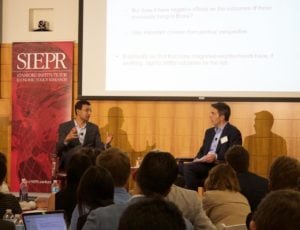
The Stanford Institute for Economic Policy Research (SIEPR) held a forum on housing policy and gentrification last Friday that featured experts in business, policy and academia. The event, titled “Gentrification: Can Policy Be the Key to Affordable Housing?” emphasized the importance of employing multiple strategies to solve the housing crisis in the Bay Area.
Some speakers advocated for government-driven solutions, such as low income housing credit, public housing and housing-choice voucher programs. Others called for a private approach, such as lightening restrictions on land use to encourage high-density housing construction. Many speakers framed the housing crisis within the context of greater issues, such as social and public health, economic mobility, transportation and racial discrimination.
Raj Chetty, professor of economics, opened the event with his research on the persistence of poverty in the U.S. He explained that for a child born to parents in the bottom fifth of the income bracket, the odds of making it to the top-fifth income group is about 7.5 percent.
However, Chetty found that a main determinant of economic mobility is childhood environment; the more time children spend in higher-mobility areas, the greater their odds of making it out of the bottom quintile and into the top.
“One of the amazing things about Raj Chetty’s work is … the amount of data that he obtained from the IRS, which nobody had ever had access to before,” said Michael Kahan, audience member and associate director of the Urban Studies program. “He’s looking at data, and [at] a level of detail in the data, that no one has ever seen before.”
Other speakers noted the importance of housing policy implementation on a local level. According to Raphael Bostic, the Judith and John Bedrosian Chair in Governance at the University of Southern California, the federal government only uses housing finance and rental assistance, and most federal policy money is used on homeowners rather than renters.
In contrast, Scott Croul, senior managing director of production and sales at Western Region Freddie Mac, encouraged taking a “private approach to a public problem.” He argued that lack of housing supply is the primary issue and building market-rate housing at high density is the primary solution.
Stringent land use and planning restrictions often prevent more housing from being built, according to Enrico Moretti, professor of economics at UC Berkeley. The main supporters of these restrictions are often people who use the “not-in-my-backyard” mantra to fight multifamily constructions in their neighborhoods, perhaps in fear of added traffic or changing demographics.
Not everyone, however, agreed with increasing housing supply. Audience member Sarah Ribeiro-Broomhead ‘19 expressed hesitations about cutting down land use restrictions.
“Restrictions are not just to slow development in general,” Ribeiro-Broomhead said. “They are put in as protections for already existing people, protections against displacement… So it’s a tough question, because we need more housing in general, and specifically affordable housing, but that often comes at the expense of existing residents. ”
Karen Chapple, professor of city and regional planning at UC Berkeley, compared the debate over the best strategy to solve the housing crisis to “debating wind or solar.” All solutions, whether it be market-rate housing, affordable housing or rent control, have their benefits.
“[Rent control] is an imperfect tool, but all of our tools are imperfect right now,” Chapple said. “We either fight against it or make something happen.”
Contact Tia Schwab at kbschwab ‘at’ stanford.edu.
